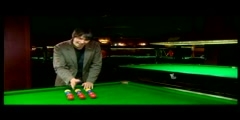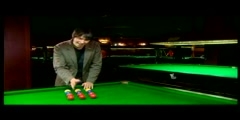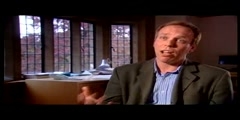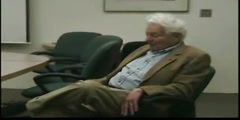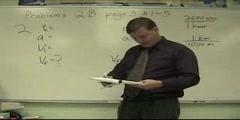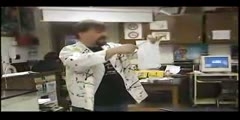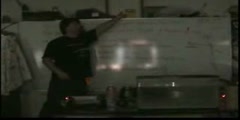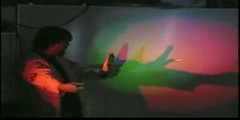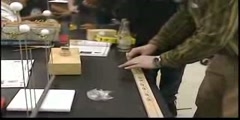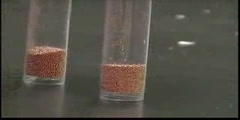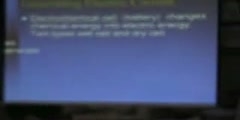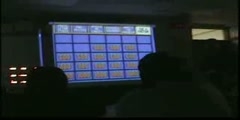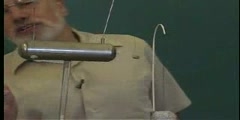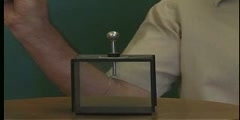Lec 11 - Physics 111: Holography (HOL)
Physics 111: Holography (HOL) Physics 111 Advanced Laboratory. Professor Sumner Davis This video accompanied the Holography Experiment, providing students with an introduction to the theory, apparatus, and procedures. This experiment is no longer in use in the Physics 111 lab. A conventional photograph records the focused image of an object on a photographic film or plate. A hologram is a photographic recording of an optical interference pattern, in this case, from a laser. The amplitude and phase of light coming from the object are stored in the hologram. The phase information enables us to reconstruct the original wavefront and hence obtain a three-dimensional image in space. Viewing a hologram is like peering through a portal into a three-dimensional space in which you can see a three-dimensional image, so real that you want to reach out and touch it. This experiment uses a 658nm diode laser as a source of coherent light, which irradiates the objects, and also provides a reference beam of uniform amplitude and phase. There are two types of holograms, both of which you will make in this lab. One is the transmission type, which needs the laser light to produce a reconstructed image. The other is a reflection hologram, which can be seen with ordinary white light from a bulb or from the sun http://advancedlab.org
Video is embedded from external source so embedding is not available.
Video is embedded from external source so download is not available.
Channels: Physics (General)
Tags: Physics 111: Holography (HOL)
Uploaded by: berkeleyphy111 ( Send Message ) on 19-09-2012.
Duration: 26m 23s
Here is the next lecture for this course
The Standard Model of Particle Physics (5 ...
03:07 | 16501 viewsThe Standard Model of Particle Physics (P ...
03:07 | 17564 viewsQED -- The Jewel of Physics (12 of 15)
03:05 | 13819 viewsLec 1 - Modern Physics: Special Relativit ...
01:49:23 | 5627 viewsPhysics First with Dr. Leon Lederman
06:17 | 10227 viewsPhysics with Mr. Noon: Homework Help
07:39 | 7282 viewsPhysics with Mr. Noon: Snell's Law
09:53 | 10143 viewsPhysics with Mr. Noon: Reflection and Ref ...
09:44 | 14613 viewsPhysics with Mr. Noon: Light and Color
09:08 | 12052 viewsPhysics with Mr. Noon: Sound Part 1
09:26 | 11355 viewsPhysics with Mr. Noon: Electrostatics 2
06:54 | 8801 viewsPhysics with Mr. Noon: Electric Current P ...
09:29 | 10569 viewsPhysics Jeopardy: Linear Motion part 1
09:39 | 11315 viewsPhysics Lab Demo 1: Introduction to Elect ...
03:31 | 11764 viewsPhysics Lab Demo 2: Electrostatic Induction
01:16 | 12887 viewsNo content is added to this lecture.
This video is a part of a lecture series from of berkeley
Lecture list for this course
Lec 1 - Physics 111: Atomic Physics (ATM) Part 1. Balmer Series
Lec 2 - Physics 111: Atomic Physics (ATM) Part 2. Zeeman Effect
Lec 3 - Physics 111: Beta Ray Spectroscopy (BRA)
Lec 4 - Physics 111: Brownian Motion in Cells (BMC)
Lec 5 - Physics 111: Instrumentation Section Lab Equipment (BSC)
Lec 6 - Physics 111: Bubble Chamber (BBC)
Lec 7 - Physics 111: Carbon Dioxide Laser (CO2)
Lec 8 - Physics 111: Compton Scattering (COM)
Lec 9 - Physics 111: Gamma Ray Spectroscopy (GMA)
Lec 10 - Physics 111: Hall Effect In A Plasma (HAL)
Lec 12 - Physics 111: Introduction to Error Analysis
Lec 13 - Physics 111: Josephson Junction Effect (JOS)
Lec 14 - Physics 111: Radiation and Laboratory Safety
Lec 15 - Physics 111: Laser Safety
Lec 16 - Physics 111: Atomic Physics (ATM) Theory Lecture ONLY
Lec 17 - Physics 111: Energy Levels Lecture Part 1
Lec 18 - Physics 111: Energy Levels Lecture Part 2
Lec 19 - Physics 111 Light Sources and Detectors Lecture
Lec 20 - Physics 111: Optical Instruments Lecture
Lec 21 - Physics 111: Energy Transitions Lecture Series
Lec 22 - Physics 111: Laser Induced Fluorescence and Raman Scattering (LIF)
Lec 23 - Physics 111: Low Light Signal Measurements (LLS)
Lec 24 - Physics 111: Non-Linear Spectroscopy and Magneto-Optics Part 1 (MNO)
Lec 25 - Physics 111: Non-Linear Spectroscopy and Magneto-Optics Part 2 (MNO)
Lec 26 - Physics 111: Atom Trapping (MOT)
Lec 27 - Physics 111: Muon Lifetime (MUO)
Lec 28 - Physics 111: Non-Linear Dynamics and Chaos (NLD)
Lec 29 - Physics 111: Nuclear Magnetic Resonance (NMR) Part-1 Continuous Wave
Lec 30 - Physics 111: Nuclear Magnetic Resonance Part-2 Pulsed NMR
Lec 31 - Physics 111: Optical Pumping (OPT)
Lec 32 - Physics 111: How to do an Oral Report
Lec 33 - Physics 111: Optical Trapping (OTZ)
Lec 34 - Physics 111: Rutherford Scattering (RUT)
Lec 35 - Physics 111: Hall Effect In A Semiconductor

